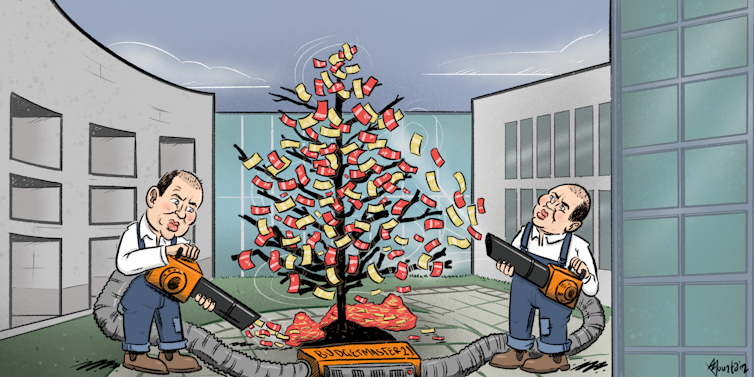Like the famous budget tree, Chalmers can change the story to suit the season
- Written by Michelle Grattan, Professorial Fellow, University of Canberra

Many people who follow federal budgets know about the magnificent “budget tree” in a parliamentary courtyard, which turns a glorious red in time for the May event.
This week Treasurer Jim Chalmers posed by the tree for pre-budget photos. As the snappers looked for a new take on an old favourite shot, Chalmers kicked the leaves. The treasurer has an eye for angles; he understands the importance of presentation and narrative as well as content.
The budget tree has its own narrative; those in Parliament House have once again watched as the tree’s changes signal the coming date. In these weeks, and indeed in the months before, Chalmers has been weaving his budget story.
Over this time, as international and Australian economic conditions have altered, so have some aspects of his preparatory narrative. No matter: when necessary he starts a fresh chapter. On the whole, Chalmers is a “no surprises” politician – his approach is to prepare the public for what’s on the cards.
As is the modern way, the government is putting out to the media ahead of time figures and announcements from the budget, in embargoed “drops”. That way, these get a clear run in the morning media, ahead of comments and criticisms from pesky stakeholders or sceptical experts. Maximum control has been achieved over the government’s pre-budget publicity. There are few genuine “leaks” of measures these days.
Among the “drops”, we’ve seen the change to the HELP indexation of student debt, and a new payment for students on teaching, nursing and social work placements. Also “dropped” has been the smaller-than-before revenue upgrade that will be in the budget. That came with Chalmers’ warning not to expect a cash splash.
A centrepiece of the budget will be the government’s controversial Future Made in Australia interventionist policy. We won’t see the umbrella legislation for this, but there will be more details about its framework. Importantly, the budget will contain tax incentives as part of the government’s effort to attract investment from overseas.
Observers will be focused on what more is said about the guardrails around Future Made in Australia, which has seen (among other initiatives) $1 billion committed to the manufacture of solar panels, which critics argue would be much better imported. We’d also expect information about the parts of the program that will be on and off budget, and about the economic rationale for the government incentivising private investment in particular sectors.
To some eyes, Future Made in Australia has a blokey feel about it – because of the nature of the projects – when the government is very sensitive to gender issues.
This sensitivity has been heightened by the recent publicity around the domestic violence crisis. More generally, the government is very attuned, in political terms, to women. In high-profile appointments, it has made clear its active search for women candidates. It has to take into account in the budget that many female voters will have even more of a gender lens on it than usual.
This is only Chalmers’ third budget but he’s been around for a lot more: as a staffer he worked on five of former treasurer Wayne Swan’s six budgets. Treasurers receive a leather-bound book of their budget papers. When Swan retired, he gave Chalmers the copy of his second budget book (2009-2010). The accompanying inscription read: “When challenges arise in your future ministerial service keep this Hansard nearby as a reminder of the cause we represent and the people we serve”.
Chalmers has fulfilled Swan’s prediction of a ministerial career. And many are presently rating him as the government’s best performer. All that attention to detail counts. But each budget presents a fresh test over the latest hurdles. And, of course, opportunities to kick some new goals.













